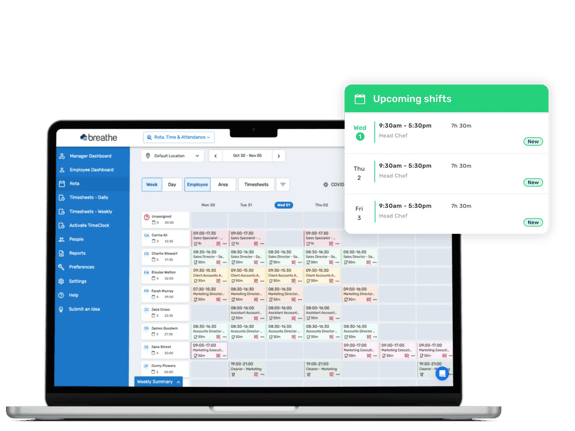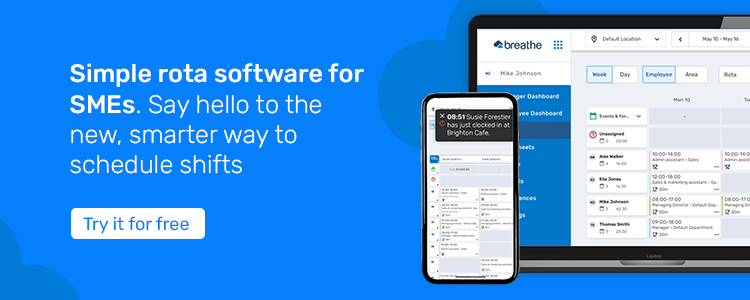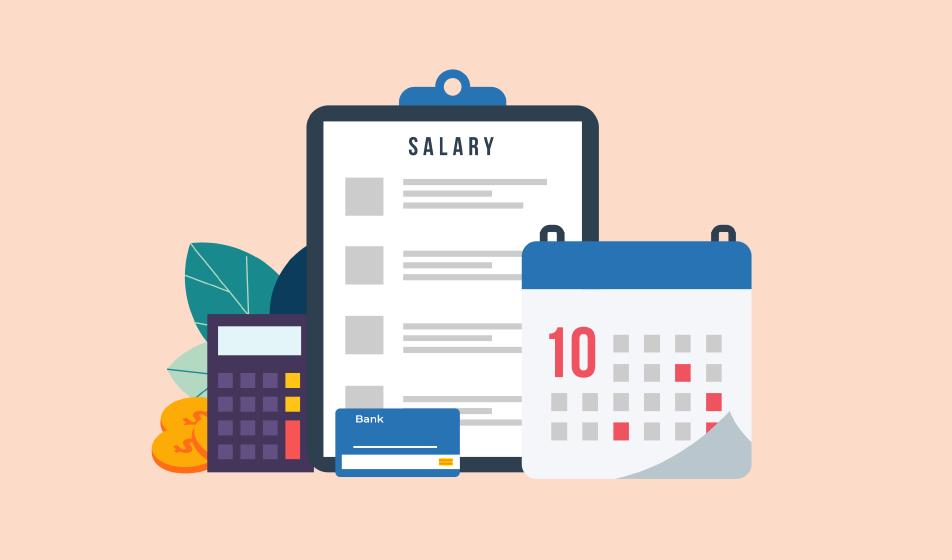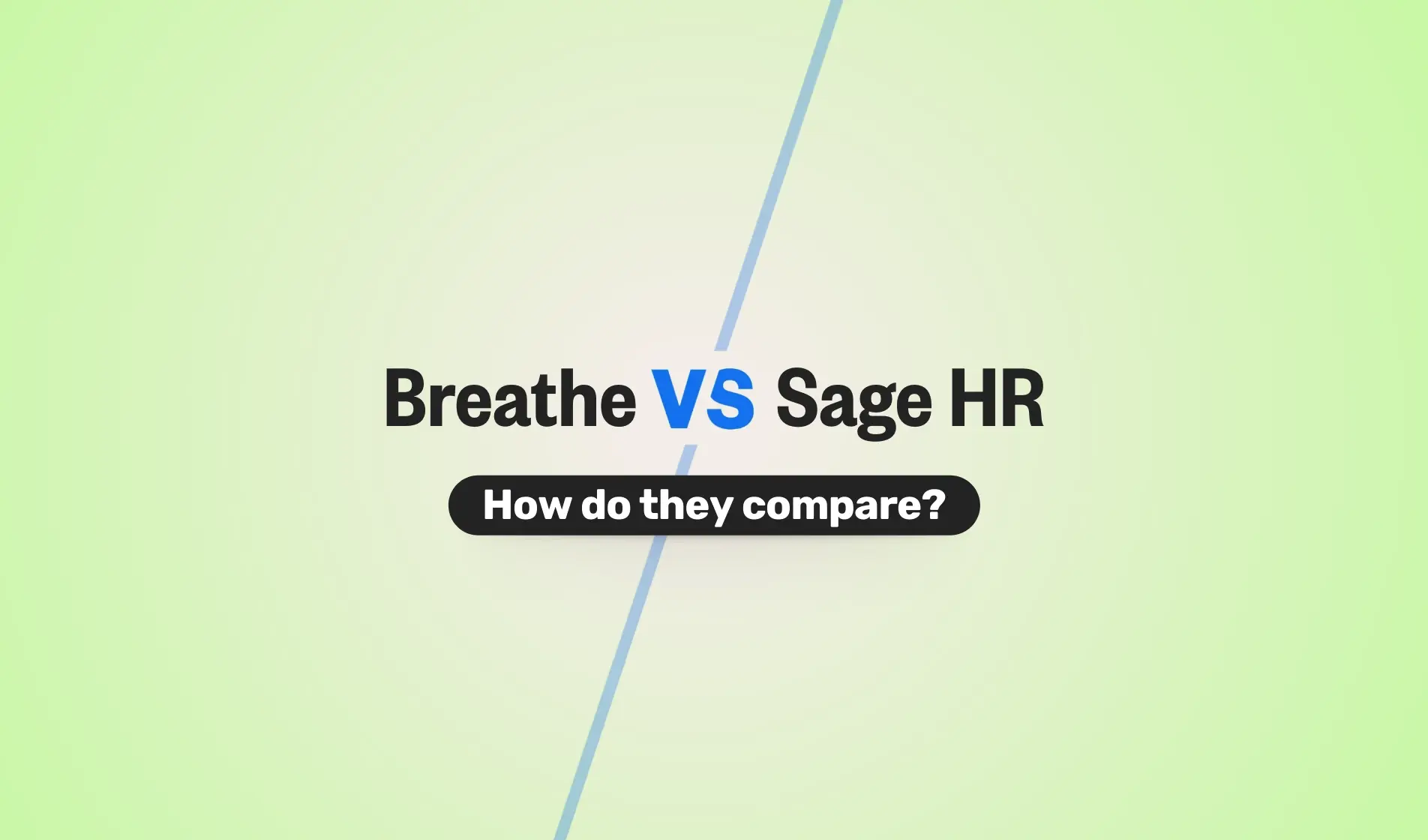To help you create the perfect rota, in this blog, we explore the different shift patterns available, helping you identify which style will suit your team & workplace.
If you’re creating a new rota, you may be unsure how to organise your staff in a way that works for them and your workplace. At Breathe we know an effective rota helps ensure your staff are fresh, motivated and happy.
Read on to discover all you need to know about...
- What are the different types of shift patterns?
- What is a two-shift pattern?
- How to implement a successful two-shift pattern
Four-on, four-off shift pattern
- What is a four-on, four-off shift pattern?
- How to implement a successful four-on, four-off shift pattern?
- What is a staggered day shift pattern?
- How to implement a successful staggered day shift pattern
- What is weekend work?
- How to implement a successful weekend work shift pattern
- What are night shift patterns?
- How to implement a successful night work shift pattern
- What is twilight and evening work?
- How to implement a successful twilight shift pattern
- What is a continental shift pattern?
- How to implement a successful continental shift pattern
- What is a Panama shift pattern?
- How to implement a successful Panama shift pattern
Frequently asked questions about shift patterns
- What laws govern shift patterns in the UK?
- Can an employer change a shift pattern without notice?
- If I have a fixed-hour contract, can I change shift patterns?
- Can I change my work shift pattern if it no longer works for me?
Work out shift patterns with ease
What is a shift pattern?
A shift pattern, also known as a work shift, is a type of working where employees are required to work in rotating shifts, usually outside of the traditional shift of 9am-5pm.
What are the different types of shift patterns?
There are many types of shift patterns that you can implement in your business, depending on your needs. Some of the most common shift types include:
-
Two-shift pattern
-
Four-on, four-off shift pattern
-
Staggered day shift pattern
-
Weekend work
-
Night shift
-
Evening and twilight shift
-
Continental shift pattern
-
Panama shift pattern
Whichever type (or types) you choose, the most important thing to do is choose shift patterns that work best for your company and employees.
Try Breathe’s HR management platform today with a 14 day free trial of Rota, Time & Attendance and never lose track of a shift rota again.
Two-shift pattern
%20timesheet%20with%20weekly%20summary-min-1.png?width=632&height=440&name=(kayleigh)%20timesheet%20with%20weekly%20summary-min-1.png) What is a two-shift pattern?
What is a two-shift pattern?
One of the most common shift patterns, the two-shift pattern will rotate two members of staff between:
-
6am-2pm
-
2pm-10pm
One will work the morning shift, while the other will work the evening. You can rotate this once a week, but depending on what best suits your staff, they might only want to change once a month or even a quarter.
How to implement a successful two-shift pattern
It's always best to discuss with your team about what suits them. This will help keep their shift rotation as routine as possible and encourage staff to develop a healthy work-life balance.
For instance, an employee may enjoy working evening shifts because they better suit their lifestyle. In this case it would be beneficial to schedule them alongside someone who would prefer morning shifts.
By balancing the needs of your employees in such a way you can create a strong work culture, encouraging the very best out of your staff.
Four-on, four-off shift pattern
.webp?width=567&height=334&name=RTA%20laptop%20%26%20mobile%20app%20(1).webp)
What is a four-on, four-off shift pattern?
A four-on, four-off work pattern works by asking staff members to work four twelve-hour shifts in a row, followed by a four-day break before their next “on” period. Following the rest period, they can then work four twelve-hour night shifts in a row again. A four-on, three-off-shift pattern uses essentially the same approach, but with fewer rest days in between the four days working.
How to implement a successful four-on, four-off shift pattern
Similar to that of the two-shift pattern, with a four-on, four-off shift pattern it’s key to ask staff if they have a preference for night or day shifts. Although it’s always best to provide a balance, by partnering a night owl with someone who prefers to work days, a happy compromise can be made.
For example, in industries like healthcare and hospitality, the four-on, four-off shift pattern may suit the needs of the workplace, while also providing ample recovery time for employees.
Staggered day shift pattern
.webp?width=454&height=454&name=Step%203%20RTA%20-%20Personalised%20(1).webp)
What is a staggered day shift pattern?
Working best as part of a two or three-week cycle, a staggered day shift pattern consists of five eight-hour days over the course of a week. Days off are then set differently for members of staff.
This ensures there is always weekend cover—making it a particularly useful shift pattern for those working in retail.
How to implement a successful staggered day shift pattern
Due to the nature of a staggered day shift pattern, it’s vital you communicate shifts well ahead of time. This then gives staff ample opportunity to plan how to best use their rest periods.
A predictive scheduling system is the simplest way to manage a staggered day shift pattern. This puts the onus on the employer to make sure all staff know their shift patterns at least two-weeks ahead of schedule.
Weekend work
What is weekend work?
If a staggered shift pattern is not enough to match how busy your workplace is at the weekend, a dedicated weekend shift pattern can be implemented instead.
A weekend rota pattern assigns a 12-hour shift to an employee over the course of a weekend. In this situation the employee will only work on weekends. This can be used in combination with a weekly shift rotation to give Monday to Friday workers a full weekend off.
How to implement a successful weekend work shift pattern
Ideally, a successful weekend work shift pattern occurs when the employee only works the weekend shift and is not expected to work during the week. This is so the employee has ample time to rest between shifts.
As with all shift patterns, however, if there is a change to an employee's shift pattern for whatever reason, this should be communicated well in advance.
Night shifts
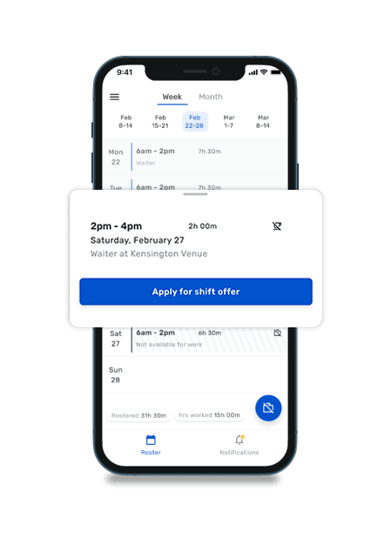
What are night shift patterns?
Ideal for some, but not for everyone, a night shift is often employed in industries where there is still demand for their service at night.
Night shifts sometimes come with extra pay due to the unsociable hours but can suit some staff members' lifestyles. They usually follow a Monday-to-Friday pattern, with a typical night shift starting at 10 pm and finishing at 6 am the next day.
This can be supplemented with dedicated weekend night staff to give the weekday employees time off.
How to implement a successful night work shift pattern
To implement a successful night shift pattern for your employees, we recommend the following tips:
-
Schedule shorter night shifts and have employees work fewer consecutive nights where possible to reduce burnout.
-
Avoid forcing your employees to work night shifts if it is not required for the business as this will affect the workplace culture and productivity.
-
Stay in touch with your night shift employees and maintain open lines of communication to improve employee morale and job satisfaction.
Twilight and evening work
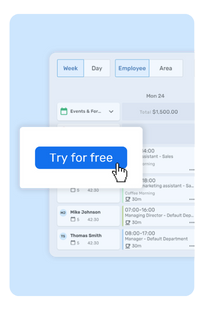 What is twilight and evening work?
What is twilight and evening work?
Some industries require afternoon and evening opening hours, known as twilight and evening work, with evening shifts usually set between 5pm-10pm or close. This is standard in hospitality and service, where bars and restaurants can open until late.
How to implement a successful twilight shift pattern
It's essential to communicate rotas ahead of schedule with an evening shift pattern, as finding a last-minute replacement staff member for an evening can be difficult. Understandably, staff not pencilled in to work could already be using the evenings to relax or be out socialising.
Taking advantage of rota scheduling software can help you avoid this kind of issue. For example, Breathe's Rota, Time & Attendance tool allows schedulers to plan weeks in advance and easily communicate any shift changes amongst employees in moments.
Continental shift pattern
What is a continental shift pattern?
Although the continental shift pattern can apply to most continuous shift pattern styles, it specifically refers to a system which employs a set of consecutive shifts. This can include seven eight-hour shifts or four twelve-hour shifts.
The pattern of shifts starts with mornings, moves through to afternoons, and finishes with night shifts. This allows fluid rotation between other members of staff. A continental shift will then be followed by two or three days’ rest, which will provide suitable recovery time for your employees.
How to implement a successful continental shift pattern
To successfully implement a continental shift pattern, you first need to get an understanding of the type of shift pattern all of your employees want to work.
Ensuring you obtain everyone's preferences should make it easier for everyone to follow the schedule as they should be assigned to their preferred shift time.
Once you have collated the information about shift time preferences, you should create a schedule that allows for the majority of people to work their preferred shift times.
This then needs to be communicated to the whole team, well ahead of time. To make communication easier, and to keep all of your HR management in one place, try a 14-day free trial of Breathe today, and take the stress out of rota scheduling.
Panama shift pattern
What is a Panama shift pattern?
The Panama shift pattern is a slow rotation style, using four teams across two twelve-hour shifts. This shift pattern provides complete coverage over a 24-hour period, seven days a week.
A great shift style for the healthcare industry, the working and non-working days include:
-
Two days on
-
Two days off
-
Three days on
-
Two days off
-
Two days on
-
Three days off
Each team will work the same rotation for 28 days before switching over with another team. One will work days, the other nights, then they'll switch.
How to implement a successful Panama shift pattern
You’ve probably guessed it by now, but the most important thing to remember when implementing a Panama shift pattern, or any shift pattern for that matter, is to ensure you have consistent, open communication with your staff to ensure the rota is right for everyone.
Specifically for a Panama shift pattern, making sure there are adequate breaks and days off between shifts is essential to keeping a productive workplace.
Statistics on UK shift work
According to the Office for National Statistics (ONS), around 27% of the UK workforce (roughly 8.7 million people) worked evening or night shifts in 2022. That's more than a quarter of the working population clocking in outside of the traditional 9 to 5.
While the number of night-time workers has dropped, from 9.5 million in 2016 to 8.7 million in 2022, it still makes up a significant part of the UK's labour market.
Frequently asked questions about shift patterns
What laws govern shift patterns in the UK?
There isn’t a specific law that governs shift patterns in the UK, however, there are a number of workplace-related laws that do influence them.
For example, the Working Time Regulations 1998 states that no employee can work over 48 hours a week on average unless the employee chooses to work more by opting out of the 48-hour week.
Can an employer change a shift pattern without notice?
An employer cannot change a shift pattern without notice or without good time to avoid confusion. However, legally, it is unclear what ‘good time’ means, and so the time frame can vary from business to business.
If I have a fixed hour contract can I change shift patterns?
If an employee has a fixed-hour contract, there needs to be a discussion and agreement made by both parties (the employee and the employer) before the change can occur.
If consent is not obtained before changing the shift pattern, this can be a breach of contract and might lead to legal action.
Can I change my work shift pattern if it no longer works for me?
If an employee wants to change their shift pattern because it no longer works for them, then they need to have an open and honest discussion with their line manager/employer. It is then up to the employer’s discretion to decide whether it is in the business interest to change your working pattern.
What is the most popular shift pattern in the UK?
There isn’t one single ‘most popular’ shift pattern, but the standard 9 to 5, Monday to Friday, and the Two-Shift pattern are both widely used.
The Two-Shift setup is a popular choice for businesses that need extended operating hours without moving into night shifts. It’s often used in industries like manufacturing, customer service and call centres, where reliable daytime coverage is essential.
Work out shift patterns with ease
If you’re looking to create a rota to help manage your workplace shift patterns, why not try Breathe's Rota, Time & Attendance tool? Choose the shift pattern style you want and plan shifts weeks in advance.
Thanks to easy edit access, staff notifications and many more useful features, Rota, Time & Attendance makes it easy to create shift patterns that work for everyone. Click on the banner below to try your 14-day free trial today.

Author: Aimée Brougham-Chandler
An IDM-certified Digital Copywriter (2023) & English Language & Literature graduate (BA Hons), Aimée is Breathe's Content Assistant. With 3 years' content marketing experience, Aimée has a passion for writing - and providing SME HR teams with solutions to their problems. She enjoys delving into & demystifying all things HR: from employee performance to health and wellbeing, leave to company culture & much more.

